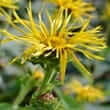Background
- Elecampane is a tall wildflower with oversized pointed leaves and yellow to orange daisy-like flowers. Elecampane is a natural source of food flavoring in Europe and is approved for use in alcoholic beverages in the United States.
- Traditionally, elecampane is used as an antifungal, antiparasitic, and general antimicrobial agent, as well as an expectorant for coughs, colds, and bronchial ailments. At this time, there is a lack of evidence from randomized, controlled trials to support these uses.
References
Natural Standard developed the above evidence-based information based on a thorough systematic review of the available scientific articles. For comprehensive information about alternative and complementary therapies on the professional level, go to . Selected references are listed below.
- Al Gammal SY. Elecampane and Job's disease. Bull Indian Inst.Hist Med Hyderabad. 1998;28(1):7-11.
View Abstract - Cantrell CL, Abate L, Fronczek FR, et al. Antimycobacterial eudesmanolides from Inula helenium and Rudbeckia subtomentosa. Planta Med 1999;65(4):351-355.
View Abstract - Chen CN, Huang HH, Wu CL, et al. Isocostunolide, a sesquiterpene lactone, induces mitochondrial membrane depolarization and caspase-dependent apoptosis in human melanoma cells. Cancer Lett 2-8-2007;246(1-2):237-252.
View Abstract - Dorn DC, Alexenizer M, Hengstler JG, et al. Tumor cell specific toxicity of Inula helenium extracts. Phytother Res 2006;20(11):970-980.
View Abstract - El Garhy MF, Mahmoud LH. Anthelminthic efficacy of traditional herbs on Ascaris lumbricoides. J Egypt.Soc Parasitol. 2002;32(3):893-900.
View Abstract - Hofbauer S, Kainz V, Golser L, et al. Antiproliferative properties of Padma Lax and its components ginger and elecampane. Forsch.Komplementarmed. 2006;13 Suppl 1:18-22.
View Abstract - Konishi T, Shimada Y, Nagao T, et al. Antiproliferative sesquiterpene lactones from the roots of Inula helenium. Biol.Pharm.Bull. 2002;25(10):1370-1372.
View Abstract - Nesterova IuV, Zelenskaia KL, Vetoshkina TV, et al. [Mechanisms of antistressor activity of Inula helenium preparations]. Eksp.Klin.Farmakol. 2003;66(4):63-65.
View Abstract - Paulsen E. Contact sensitization from Compositae-containing herbal remedies and cosmetics. Contact Dermatitis 2002;47(4):189-198.
View Abstract - Paulsen E, Andersen KE, Hausen BM. Sensitization and cross-reaction patterns in Danish Compositae-allergic patients. Contact Dermatitis 2001;45(4):197-204.
View Abstract - Spiridonov NA, Konovalov DA, Arkhipov VV. Cytotoxicity of some Russian ethnomedicinal plants and plant compounds. Phytother Res 2005;19(5):428-432.
View Abstract - Stojakowska A, Kedzia B, Kisiel W. Antimicrobial activity of 10-isobutyryloxy-8,9-epoxythymol isobutyrate. Fitoterapia 2005;76(7-8):687-690.
View Abstract - Stojakowska A, Malarz J, Kisiel W. Thymol derivatives from a root culture of Inula helenium. Z.Naturforsch.[C.] 2004;59(7-8):606-608.
View Abstract - Stojakowska A, Michalska K, Malarz J. Simultaneous quantification of eudesmanolides and thymol derivatives from tissues of Inula helenium and I. royleana by reversed-phase high-performance liquid chromatography. Phytochem.Anal. 2006;17(3):157-161.
View Abstract - Zelenskaya KL, Povet'eva TN, Pashinskii VG, et al. Stress-inducing effect of hypoxia of different origin and its correction with Inula Helenium L. tincture. Bull Exp.Biol.Med 2005;139(4):414-417.
View Abstract







